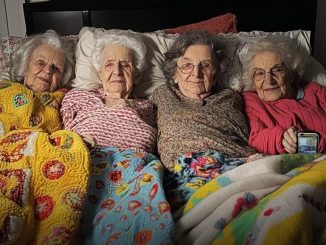
It’s a no-brainer that sleep is vital for one’s health. That is why so many researchers study the best way to get good quality shut-eye. However, forget chamomile tea and meditating before bed. According to new research, women sleep better next to dogs. That’s right; Canisius College in New York State conducted a study that found that canines make better-sleeping partners than humans or cats.
“We found that women commonly rate dogs as better bed partners than cats and human partners and report that their dogs enhance their sleep quality,” Christy Hoffman, Ph.D., animal behaviorist and lead researcher of the study.
Research Finds that Women Sleep Better Next to Dogs
Hoffman surveyed almost one thousand women living in the United States to come to these findings. The results showed that 55% of the participants shared their bed with at least one dog and 31% with at least one cat. Also, 57% of these women shared a bed with a human partner, while the rest did not. [1]
Hoffman also discovered why dogs seemed to make the best bed companions. The first reason is that dogs’ sleeping patterns, as opposed to cats, more closely resemble those of humans.
“The difference between dogs and cats is not surprising because dogs’ major sleep periods tend to coincide more closely with humans’ than do cats,’” said Hoffman.
However, while there may be benefits of these similar sleeping patterns, more research is needed to know for certain. But Hoffman has some ideas of how this could work.
“In comparison to human bed partners, dogs may be better at accommodating their human’s sleep schedule,” she said. “It’s not uncommon for human bed partners to go to bed at very different times and wake up at very different times. Such differences in partners’ schedules can certainly disrupt sleep. It may be that dog bed partners adapt more readily to their owner’s schedule than do human bed partners.”
Moreover, dogs require certain schedules and responsibilities, such as a morning walk. This kind of regime helps their owners maintain a routine, improving sleep quality as a result.
Stillness and Security
Additionally, dogs tend to stay stiff as they sleep. Anyone who’s slept with a fidgety partner knows how disruptive they could be. However, women in the study reported that their dogs stayed on the bed most of the night instead of felines, who tended to come and go.
“This suggests that cats may be more likely than dogs to create disruptions by moving on and off the bed during the night. In addition, we found that dog owners kept to more consistent bedtime and wake time schedules than cat owners and also tended to go to bed earlier and wake up earlier than cat owners,” Hoffman said.
Here’s the third and most important reason: Canines provide a sense of security to their owners. More so than with cats or even human partners.
“Some dog owners may take comfort in the thought that their dog will alert them in the case of an intruder or other type of emergency; furthermore, a dog’s bark may deter a potential intruder. A cat is less likely to take on this role, and so, may not provide psychological comfort in the same way a dog might,” said Hoffman.
The Best Partner for Quality Sleep
However, while the study suggests that dogs are the perfect slumber buddies, their benefits are subjective to each case. For example, a dog could snore or make the bed too hot. Additionally, there are many owners who find that their cats help them sleep.
Keep in mind that the research was based on how the volunteers perceive their pets’ effects on their sleeping quality and duration. As a result, more objective research is needed to definitively consider dogs the superior sleeping partners. However, Hoffman believes that these studies could be beneficial as many American households have pets.
“It will be valuable to continue this line of research so we can develop a clearer picture of the contexts under which pets and their presence in their owner’s bed may positively impact sleep quality, and the contexts under which co-sleeping with a pet may be detrimental to one’s sleep quality,” she said.
For instance, research has also shown that women sleep better while alone than with a human, but many believe in the opposite. Future research could use Fitbit-like devices to objectively track the sleep quality of people in different sleeping conditions.
Unveiling My Spouse’s Hidden Truth on Our Initial Wedding Night

In a narrative of openness and affection, Jenny and Alex navigate the repercussions of a childhood ordeal that surfaces during their marriage’s inception. As Jenny grasps the extent of Alex’s apprehension, ignited by a harrowing incident from his past, she embraces a role of empathy and encouragement.
Falling profoundly for Alex was akin to embarking on an enigmatic tale where the conclusion remains a mystery. We encountered each other in what felt like a whirlwind romance; it didn’t take us long to determine that we desired a lifetime together. We opted for patience, keeping our bond purely spiritual and emotional, which remarkably deepened our connection.
Alex, with his guarded demeanor, hinted at a somber chapter from his youth, one he wasn’t prepared to disclose. Knowing he entrusted me with even that small revelation strengthened our bond further. It’s as if we’re co-authors of this love story, navigating each chapter together.
Throughout our wedding preparations, traces of Alex’s past and his concealed truth began to surface more frequently. I noticed, but I refrained from pressing him to reveal something he wasn’t ready to share. It left me with a blend of curiosity and reverence for Alex’s privacy, opting to focus on the love and anticipation of our imminent marriage. Even when I attempted to express my concerns, my mother-in-law swiftly dismissed them, assuring me everything was fine.
My relationship with Mrs. Green, Alex’s mother, evolved into something truly exceptional. She wasn’t just a mother-in-law but a confidante and friend. When it came time to select gifts for Alex’s birthday and Christmas, she served as my trusted advisor, ensuring each gift was thoughtful and personal.
The gesture that solidified our bond was when she entrusted me with their family heirloom ring—a gesture of acceptance and trust. It wasn’t merely a piece of jewelry; it symbolized acceptance into the family, a testament to the affectionate and trusting relationship we shared.
Following our magnificent wedding day, filled with dancing, heartfelt speeches, and boundless love, Alex and I were utterly exhausted by the time we reached our room. Every moment was precious, from the heartfelt vows to the lively dance floor antics and the countless photos with everyone. Honestly, just recollecting how we managed to endure it all is making me weary once more.
Nestling into bed felt like a serene escape, a moment to truly savor the joy of the day. Despite our weariness, there was a beautiful sense of embarking on our life journey together, a mixture of excitement and a profound, comforting exhaustion.
As I awaited in bed, adorned in my finest attire, I overheard him conversing with his mom behind the door. Mrs. Green? What was she doing here? Surely, she wouldn’t become one of those mothers-in-law who feel the need to offer guidance to their precious son on the first night! Or worse, could she be here to instruct me?
“Mom, I can’t do it. Can you come in?”
My heart raced as the door creaked open. I sheepishly pulled the covers up to my chin and gazed at them in disbelief.
“What’s going on?”
After a brief silence, during which Mrs. Green seemed to ponder her response, she turned to her son, her eyes wide. “Wait. Have you told her about the—”
Alex shook his head.
“Then do! What have you been thinking about?! The poor thing must be thinking we’re a pair of oddballs!”
Alex met my gaze with a solemn expression before heaving a sigh and beginning to divulge his deepest secret.
“When I was merely 5 years old, the unimaginable occurred—a burglar shattered the tranquility of our home by intruding through my bedroom window. That night, shrouded in darkness, my world was forever altered. The intruder’s silhouette, a menacing presence in my sanctuary, left me paralyzed with fear, unable to utter a sound or escape. The aftermath of that violation instilled in me a profound and enduring fear that lingered long after the shattered glass was swept away and the window secured.
“In the nights that ensued, my bedroom resembled a battleground, with each shadow serving as a reminder of my vulnerability. Sleep, once a refuge, became an insurmountable challenge. Yet, amidst my terror, my mother emerged as my guardian angel.
“Night after night, she remained by my bedside, her presence a beacon of safety in the darkness. With the soothing cadence of her voice, she wove tales of bravery and adventure, narrating stories of heroes who confronted their fears and emerged triumphant. Her words, gentle and reassuring, served as a salve to my terrified soul, guiding me toward the tranquil shores of sleep.
“These bedtime narratives, more than mere stories, became our ritual, a shared voyage back to a sense of normalcy and security. My mother’s unwavering devotion and love taught me that even in the grip of paralyzing fear, there exists a reservoir of strength within us, a resilience that can be nurtured and cultivated.
“Since that fateful night, my mother has been my constant companion in the pursuit of peace as I drift off to sleep, her presence a reminder that even in our darkest moments, we are not alone.”
Learning of Alex’s secret left me reeling, a whirlwind of emotions swirling within me. Initially, there was shock, as the depth of his trauma surpassed my expectations. Then came understanding, a realization of the burden he had carried all these years. My heart ached for him, for the child he once was and the man he had become.
With this newfound knowledge, there also came a renewed determination, a resolve to be the support he needed. Love, after all, means standing united, especially in the face of hidden struggles.
“So… how can I assist you?” I inquired, grasping his hand. Suddenly, the atmosphere in the room felt warm and comforting, like a cozy blanket.
“When Alex feels anxious or overwhelmed, particularly at night, embracing him in a specific manner has always provided solace,” Mrs. Green began, her tone serene and reassuring. “Hold him close, with his head resting near your heart. It’s a technique that has comforted him since childhood.
“Although he has mostly outgrown this need, his anxiety can still overwhelm him during times of stress. It’s crucial to be patient and understanding, offering him that physical reassurance. This approach has often been instrumental in helping him find tranquility and drift off to sleep.”
In that tender moment, as I cradled Alex in the manner his mother described, I felt a profound connection between us. His head nestled near my heart, and gradually, his tense demeanor melted into the embrace. Despite the initial shock of learning about his anxiety, understanding washed over me, bringing a deep sense of empathy and readiness to support him.
As he finally succumbed to sleep, the weight of his worries seemed to diminish. Mrs. Green, witnessing this scene, quietly exited the room with a silent nod of approval and gratitude in her eyes. It was evident she found solace in knowing her son was in caring hands.
Following that pivotal night, Alex and I embarked on a transformative journey. We became more open, delving deeper into understanding and supporting each other’s needs. Learning to alleviate his anxieties became an integral part of our lives, and truthfully, it brought us closer.
We confronted his vulnerabilities head-on, finding strength in each other. Our journey resembled a crash course in love, empathy, and resilience. It’s remarkable how facing challenges together has only strengthened our bond. I just wanted to share our small triumph—love truly conquers all.



Leave a Reply